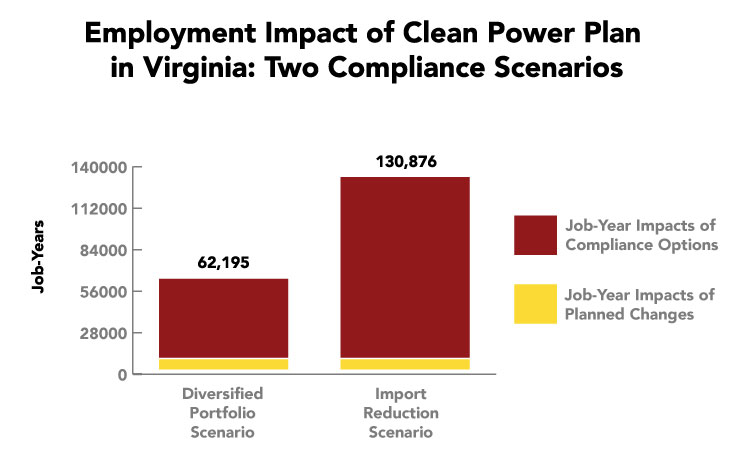Last week, Advanced Energy Economy Institute (AEEI) and the Virginia Advanced Energy Industries Coalition (VAEIC) released a new report, “Assessing Virginia’s Energy Future,” which measures the employment outcomes of two potential Clean Power Plan (CPP) compliance strategies that the Commonwealth might consider. The topline finding is quite simple: Virginia could create thousands of permanent and temporary construction jobs by implementing the CPP, and double the number of jobs if the Commonwealth chooses to pursue a goal it has considered for a long time – producing within the state all the electricity needed to power the Virginia economy, instead of importing nearly 40 percent from out of state. It will be up to Gov. Terry McAuliffe and the General Assembly to choose which course to take.
VIRGINIA EMPLOYMENT IMPACTS BY YEAR; ENERGY IMPORT REDUCTION SCENARIO
Green area: New advanced energy job years; Red area: Job years lost

The two scenarios examined in the report are “Diversified Portfolio” and “Import Reduction” pathways. Both options are built on a baseline established by the state’s investor-owned utilities via the Integrated Resource Planning process. Even the plans submitted by the utilities have old, inefficient coal-fired power plants retiring, based on economic factors. These retirements will get Virginia much of the way to the emissions target set by the EPA in its proposed plan.
To get the rest of the way, the Diversified Portfolio approach would achieve compliance by implementing changes already planned by the utilities, plus most of the building block measures outlined by the Environmental Protection Agency (EPA) in the draft rule and some additional investments in renewable energy and energy efficiency. This scenario would result in a net impact of 54,231 job-years between now and 2030. The added jobs would peak at 5,700 in 2027.
Job growth would double under the Import Reduction scenario, which would not only meet Virginia’s emission reduction target but also achieve a long sought policy goal of eliminating electricity imports. For years, leaders in Richmond have bemoaned the fact that 40 percent of the electricity Virginia consumes comes from out of state, draining precious dollars from the Virginia economy. Achieving self-sufficiency in electricity generation while meeting EPA emissions standards would create 122,000 job-years of additional employment over the next 15 years, with net new jobs peaking at 12,600 in 2029 (see Figure 10 in the full report). That’s nearly equal to the employment in commercial construction today.

In either scenario, Virginia keeps the lights on with a combination of natural gas generation, renewable energy development, and energy efficiency improvement. This combination of resources meets Virginia’s energy needs while reducing greenhouse gas emissions – and creating jobs.
In both scenarios, the large volume of new jobs comes from investments in energy efficiency and solar power, both of which are very labor intensive.
Energy efficiency also saves money, as investments that reduce energy use also reduce utility bills. The American Council for an Energy Efficient Economy (ACEEE) says that the Commonwealth could reduce its energy consumption 19% by 2025, saving money for consumers as well as kilowatt-hours. Reducing peak demand, which drives up rates for everyone all year round, with demand response programs that reward business and residential consumers for reducing their energy use at the times that matter most, could achieve 7% savings in the summer months, saving money and reducing stress on the grid.
Above all, meeting Virginia’s needs for electricity from secure, local sources that also meet emission standards set by EPA will create job opportunities and keep Virginians’ utility dollars in the state. It will also give Virginia control over its energy future.
AEE and VAEIC are working to make sure this jobs potential does not go unnoticed. VAEIC board president Francis Hodsoll published an op-ed in the Virginian-Pilot, arguing that businesses are coming to see Clean Power Plan compliance as “a chance to foster long-term growth, drive prudent energy diversification and create thousands of new jobs. More importantly,” Hodsoll emphasized, “Virginia can leap from a laggard to a leader in the high-growth, jobs-intensive advanced energy industry.”
Hodsoll led a delegation of business leaders, including representatives of AEE member Opower and Apex Energy to Richmond to brief Gov. McAuliffe’s staff on the report, and printed copies are on their way to every Virginia legislator.
Which direction will elected officials in Virginia take? The path that is well worn, with entrenched technologies, or a path toward the technologies of today that create thousands of jobs for the Commonwealth’s economy tomorrow? To AEEI and VAEIC, this is no choice at all.
To read the full report, “Assessing Virginia’s Energy Future,” and to see a more detailed version of the above graph, click the button below.
